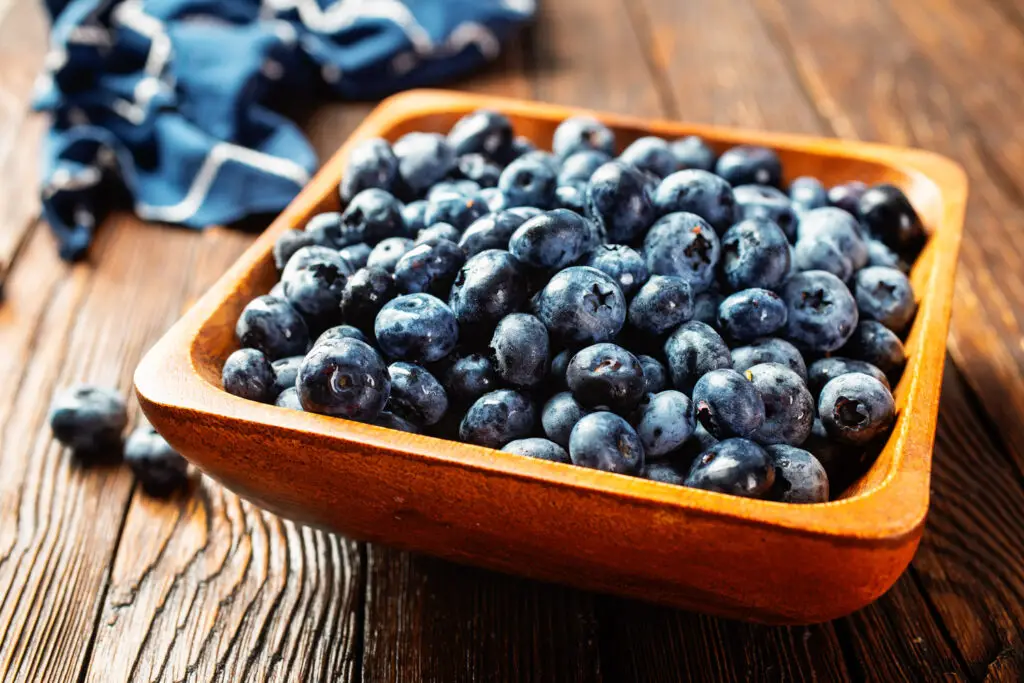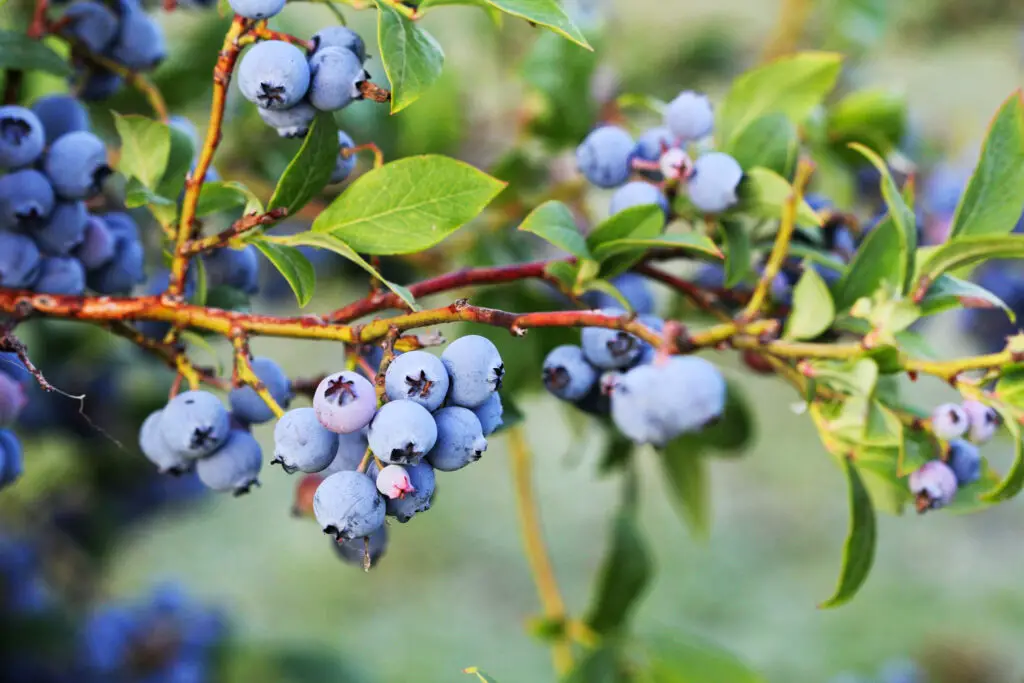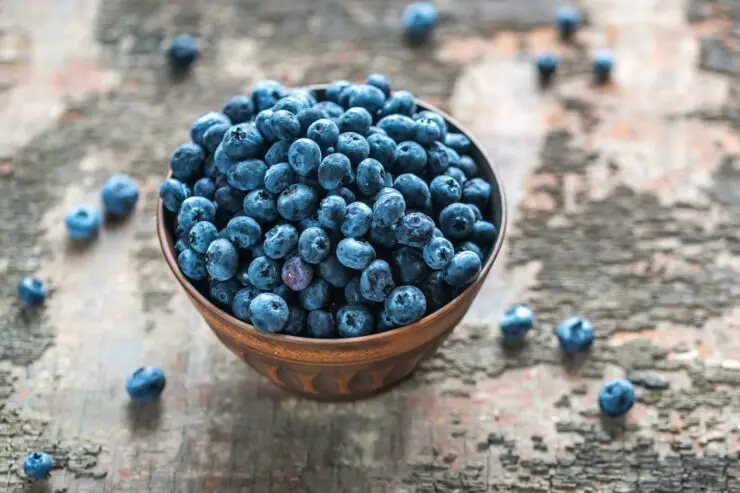As an Amazon Associate I earn from qualifying purchases. Please read the disclaimer for more info.
Chilean Blueberries, renowned for their delicious taste and high nutritional value, have become a staple in diets around the globe due to their large-scale production. A member of the Vaccinium family, these tiny flavorful blueberries pack a punch regarding health benefits thanks to their rich antioxidants, vitamins, and fiber content.
Originating from North America, they have been cultivated and enjoyed for centuries, with their popularity growing over time.
Blueberries are significant in consumption and production in the global fruit market. According to the United Nations Food and Agriculture Organization, blueberries rank among the top five fruits exported worldwide, highlighting their importance in international trade.
Their versatility in various products, from jams and juices to pastries and health supplements, further underscores their prominent role in the global food industry.
The cultivation of fresh blueberries has expanded beyond its original territories, with various countries across different continents joining the production bandwagon.
Among these, Chile has emerged as a leading player. Chilean blueberries, known for their unique taste and texture, have carved out a niche for themselves in this competitive market.
Related: 19 Delicious Chilean Fruits: Taste The Exotic
Origins, History, and Domestication of Chilean Blueberries

The history of blueberries in Chile began in the late 1990s when they were first planted in the country’s southern regions. The decision to cultivate blueberries was primarily driven by high prices for the fruit during October and November, which provided a lucrative opportunity for farmers in Chile.
The journey from the initial planting to becoming the largest global exporter of blueberries has resulted from consistent efforts focused on quality and innovation. Chile’s unique geography and climate conditions, characterized by warm summers and mild winters, have played a crucial role in successfully cultivating these berries.
The domestication process also involved the introduction of new varieties from other parts of the world, such as the New Zealand-origin blueberry variety called ‘Centra Blue.
Chilean blueberries are known for their unique taste and texture, making them a favorite among consumers worldwide. The berries are typically larger and firmer than their counterparts from other regions, with a sweet, slightly tart flavor that makes them ideal for a wide range of culinary uses.
Moreover, the Chilean Blueberry Committee’s creation was instrumental in promoting the quality of Chilean blueberries and generating demand for their exports.
This focus on quality over quantity has helped Chilean blueberries carve out a niche for themselves in the global market.
Related: Delicious Chilean Cherries: Taste, Health Benefits, and Culinary Uses
Varieties of Chilean Blueberries
Chile is home to a diverse range of blueberry varieties, each with its unique characteristics and flavors. The selection of varieties cultivated in Chile’s blueberry growing regions has been carefully chosen to suit the country’s unique climatic conditions and to meet international market demands.
Some of the common types of blueberries grown by Chilean blueberry farmers include the Biloxi, Bluecrop, Brigitta, Duke, and Legacy varieties. Each of these blueberry varieties has its unique features:
- Biloxi: This variety is known for its early harvesting period and its ability to produce a high yield of large, bright blue berries with a mildly sweet flavor.
- Bluecrop: One of the most widely grown varieties worldwide, Bluecrop blueberries are medium to large in size, with a sweet taste and firm texture. They are highly resistant to cold and can adapt to various soil conditions.
- Brigitta: These blueberries are large, light blue, and slightly tart. Brigitta blueberries have a longer shelf life than other varieties, making them ideal for export.
- Duke: Duke blueberries are early-season berries known for their large size and sweet flavor. They have a robust, crunchy texture and hold up well during transport.
- Legacy: Legacy blueberries are known for their sweet, rich flavor and firm, crisp texture. They are mid to late-season berries and highly resistant to heat and cold.
Compared to traditional blueberries, Chilean blueberries tend to be larger and firmer, thanks to the country’s optimal growing conditions.
Furthermore, the diverse range of varieties grown allows for an extended harvesting period, contributing to Chile’s position as a leading global exporter of blueberries.
The harvest season for Chilean blueberries typically begins in October and runs until April. Chile’s unique geography and climate make it possible to produce a variety of blueberry varieties throughout the year, providing a steady supply of berries to the global market.

Related: The Delicious Taste of Chilean Apples
Nutritional Value of Blueberries
Blueberries contain a host of nutrients that contribute to maintaining a healthy body. They are low in calories and high in essential vitamins and minerals, making them an excellent choice for a healthy diet.
One cup (148g) of raw blueberries provides approximately 84 calories[^1^]. About 91% of these calories come from carbohydrates, 5% from protein, and the remaining 4% from fat.
Most of the carbs in blueberries are simple sugars responsible for their sweet taste. They are naturally fat-free.
Blueberries are particularly rich in Vitamin C and Vitamin K. A cup of blueberries provides about 25% of the daily recommended intake of Vitamin C, known for its antioxidant properties and role in boosting the immune system.
The same serving also provides a substantial amount of Vitamin K, which is crucial in blood clotting and bone health.
In addition to these vitamins, blueberries are a good source of fiber, providing about 4 grams per serving. Dietary fiber is vital for digestive health and can help to maintain a feeling of fullness, which can assist in weight management.
Blueberries also contain other important minerals like manganese and potassium. Manganese is necessary to metabolize amino acids, proteins, and carbohydrates, while potassium helps regulate fluid balance, muscle contractions, and nerve signals.
Another noteworthy aspect of blueberries’ nutritional profile is their high content of antioxidants, particularly anthocyanins, which give blueberries their distinctive blue color. These antioxidants have been linked to several health benefits, including heart health, brain health, and anti-inflammatory effects.
For a more detailed look at the health benefits of blueberries, you can read:
- Health Benefits of Blueberries – WebMD
- Blueberries 101: Nutrition Facts and Health Benefits – Healthline
Related: Chilean Papaya: A Sweet Exotic Treat From The Andes
Production and Trade of Chilean Blueberries
Chile has emerged as a major player in the global blueberry market, with its unique climate conditions and innovative farming practices contributing to its success.
Key Growers and Their Role in the Industry
The Chilean blueberry industry is characterized by a mix of small, medium, and large-scale Chilean blueberry growers, all playing a crucial role in maintaining the high quality and volume of production.
Many of these growers are part of the Chilean Blueberry Committee, which promotes their quality of them and generates demand for the export markets.
One of the prominent players is Fall Creek Farm & Nursery, which serves Chilean growers by focusing on providing them with the best blueberry plant stock and horticultural support.
Chilean blueberries are grown in regions such as O’Higgins, Maule, and Bio Bio.
Economic Impact of the Blueberry Industry in Chile
The blueberry industry has had a significant economic impact in Chile. It has created jobs in rural areas with otherwise limited career opportunities. Furthermore, the United States is the top market for Chilean fresh and frozen blueberries, receiving more than half of the Chilean export volume.
Current Market Trends
Over the last decade, the planted area of blueberries in Chile has increased by 150%, reflecting the growing popularity and demand for this berry. However, the industry focuses on quality over quantity, ensuring that the blueberries exported meet the highest standards.
In conclusion, the production and trade of Chilean blueberries play a significant role in the country’s economy, providing jobs, promoting agricultural innovation, and contributing to the global supply of this nutritious fruit.
Challenges in the Chilean Blueberry Industry
Despite its success in global markets, the Chilean blueberry industry faces several challenges that could potentially impact production and trade.
Potential Obstacles in Blueberry Production and Trade
- Climate Change: Climate change poses a significant challenge to the blueberry industry. Temperature changes can affect areas where blueberries were previously thriving.
- Water and Labor Problems: Blueberry growers must contend with issues such as water scarcity and labor shortages. These problems can hinder the growth and harvesting of blueberries, affecting overall production levels.
- Increased Global Competition: The rise of blueberry production in other countries like Peru, Morocco, and Mexico has increased competition, affecting Chile’s market share.
- Lower Profitability: Factors such as unfavorable exchange rates and higher costs lead to lower profitability for blueberry growers.
- Quarantine Regulations: As the United States is the main target market for Chilean blueberries, the fruit requires different treatments for entry due to quarantine-type regulations, which can be challenging.
Strategies for Overcoming These Challenges
- Adapting Varieties: To combat climate change and water scarcity, some growers are considering changing their plantations for more resistant varieties.
- Technological Innovations: Using technologies can help address some of the challenges the Chilean blueberry industry faces. For instance, technology can aid in meeting the quarantine requirements for exporting to the United States.
- Maintaining Quality: Despite the increased global competition, Chile can maintain its competitive edge by focusing on the quality of its blueberries.
In conclusion, while the Chilean blueberry industry faces several challenges, it has potential strategies to overcome them. By adapting and innovating, the industry can continue to thrive and maintain its position in the global market.
Popular Recipes Using Flavorful Blueberries

- Blueberry Scones: These scones are light and fluffy, perfect for breakfast or an afternoon snack! Recipe at Amy’s Healthy Baking
- Blueberry Cobbler: A classic dessert made with ripe blueberries and topped with a buttery biscuit crust. Recipe at Tastes Better From Scratch
- Blueberry Pancakes: Start the morning off right with these fluffy pancakes loaded with blueberries! Recipe at King Arthur Baking.
- Blueberry Muffins: Moist and flavorful muffins that are great for breakfast or afternoon snacks. Recipe at Sally’s Baking Addiction
Thanks to these delicious recipes, it’s easy to incorporate Chilean blueberries into your daily diet. Whether you’re looking for breakfast, lunch, dinner, or dessert ideas – there’s something for everyone!
Final Thoughts on Chilean Blueberries
Chilean blueberries are a nutritious and delicious fruit that is popular worldwide. Chilean growers are at the forefront of keeping up with market trends and providing consumers top-notch quality. Despite some challenges, they have strategies to overcome them, ensuring that production and trade continue to thrive.

